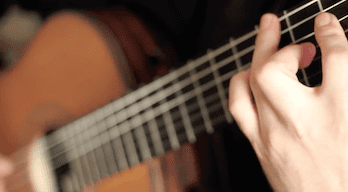Our default reaction to difficulty or intensity, as humans, seems to be to overcompensate with tension. On the classical guitar this overcompensation is very present in the left hand. For instance, if we play a loud chord with our right hand, we tend to add more pressure to the strings with our left hand. This makes no sense at all in terms of playing the music but it has to do with separating the roles of each hand and also the intrinsic connection we all seem to have between loud and tense. Technical difficulty can also bring on some overcompensation in the left hand, which is a horrible thing really, because if there is any time we need to be relaxed and flowing, it is in times of difficulty. Much like the fight or flight effects found in stage fright, these reactions are hard wired into us, so we have to work diligently to change that wiring around.
It is possible to sometimes forget just how easy it is to hold down a guitar string. When our left hand is required to do many complex movements and move rapidly in synchronization with the right hand we can forget to relax and end up using much more pressure than we need. That pressure builds up and can cause aches and pains in the palm and forearm. It also makes playing more difficult than it needs to be.
Buzzing
The Buzzing exercise is wonderful at letting you know just how “easy” playing the guitar can be and it provides a great way to re-train the left hand to play with less pressure.
When a string is pressed down very lightly so as to play a note but not enough to make a clear tone there is a buzzing sound that comes from the string. You can find this sound by pressing down very lightly on the string so it sounds dampened and then increase the pressure until you hear the note clearly. Experiment with the sensation of lightness and ease that it takes to play the note clearly and then find the half way point in between a dampened sound and a clear note where it buzzes.
Once you have found a good buzzing sound then you can use it to practice scales, exercises or whole pieces. Because the amount pressure needed to buzz the string is quite exact you will start to gain more control over your finger pressure in the left hand. Keep in mind that the goal here is not to make all of your notes buzz, but rather to gain a new sensation of lightness with the left hand and to control the pressure of the fingers.
After buzzing for a while, go back to normal playing and you might find that the sensation of lightness is quite surprising. This exercise is really wonderful at letting you know just how “easy” playing the guitar really is!


Leave A Comment